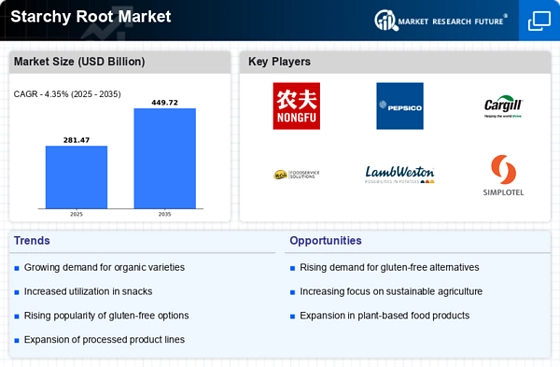Culinary Versatility
The culinary versatility of starchy roots is another significant driver for the Starchy Root Market. These ingredients can be utilized in a myriad of dishes, ranging from traditional cuisines to modern culinary innovations. Their adaptability allows for incorporation into various diets, including vegan and gluten-free options, which may enhance their appeal. For instance, the use of cassava flour in baking has gained traction, reflecting a broader trend towards alternative flours. This versatility not only caters to diverse consumer preferences but also positions the Starchy Root Market favorably in the food sector. As culinary trends evolve, the demand for starchy roots is likely to expand, further solidifying their role in contemporary gastronomy.
Rising Health Awareness
The increasing awareness of health and nutrition among consumers appears to be a pivotal driver for the Starchy Root Market. As individuals become more conscious of their dietary choices, the demand for starchy roots, such as sweet potatoes and yams, is likely to rise. These roots are often perceived as healthier alternatives to refined carbohydrates, which may contribute to their growing popularity. According to recent data, the consumption of sweet potatoes has surged by approximately 20 percent over the past five years, indicating a shift towards more nutritious food options. This trend suggests that the Starchy Root Market could experience substantial growth as health-conscious consumers seek out natural, nutrient-dense foods.
Growing Demand for Plant-Based Foods
The escalating demand for plant-based foods is poised to significantly impact the Starchy Root Market. As more consumers adopt vegetarian and vegan lifestyles, the need for plant-derived sources of carbohydrates becomes increasingly critical. Starchy roots, being rich in carbohydrates and essential nutrients, serve as a vital component in plant-based diets. Recent statistics indicate that the plant-based food market has grown by over 25 percent in the last three years, suggesting a robust shift in consumer preferences. This trend may drive the Starchy Root Market to innovate and expand its offerings, catering to a demographic that prioritizes plant-based nutrition.
Sustainability and Environmental Concerns
Sustainability and environmental concerns are emerging as crucial drivers for the Starchy Root Market. As consumers become more aware of the environmental impact of their food choices, there is a growing preference for sustainably sourced ingredients. Starchy roots, often cultivated with lower environmental footprints compared to other crops, may benefit from this trend. The adoption of sustainable farming practices, such as crop rotation and organic farming, is likely to enhance the appeal of starchy roots. This shift towards sustainability could potentially lead to increased market share for the Starchy Root Market, as eco-conscious consumers seek out products that align with their values.
Technological Advancements in Agriculture
Technological advancements in agriculture are likely to play a pivotal role in shaping the Starchy Root Market. Innovations such as precision farming, biotechnology, and improved irrigation techniques may enhance crop yields and quality. These advancements can lead to more efficient production processes, reducing costs and increasing the availability of starchy roots in the market. For instance, the implementation of smart farming technologies has shown to improve yields by up to 30 percent in certain regions. As these technologies become more widespread, the Starchy Root Market could experience a boost in productivity, meeting the rising demand for starchy roots while ensuring sustainability.

















Leave a Comment